Palm sugar is a delicious sweetener made from the nectar of the coconut or toddy palm flowers. It's an integral ingredient in Thai and Southeast Asian cooking, especially desserts. It is what I like to call the "original sugar" in traditional Thai cuisine before white granulated sugar became a thing.
However, I get a lot of questions about it and importantly not all palm sugars are created equal. So in this article I will answer all of your questions so you have the confidence to buy the right palm sugar, and know how to use it.
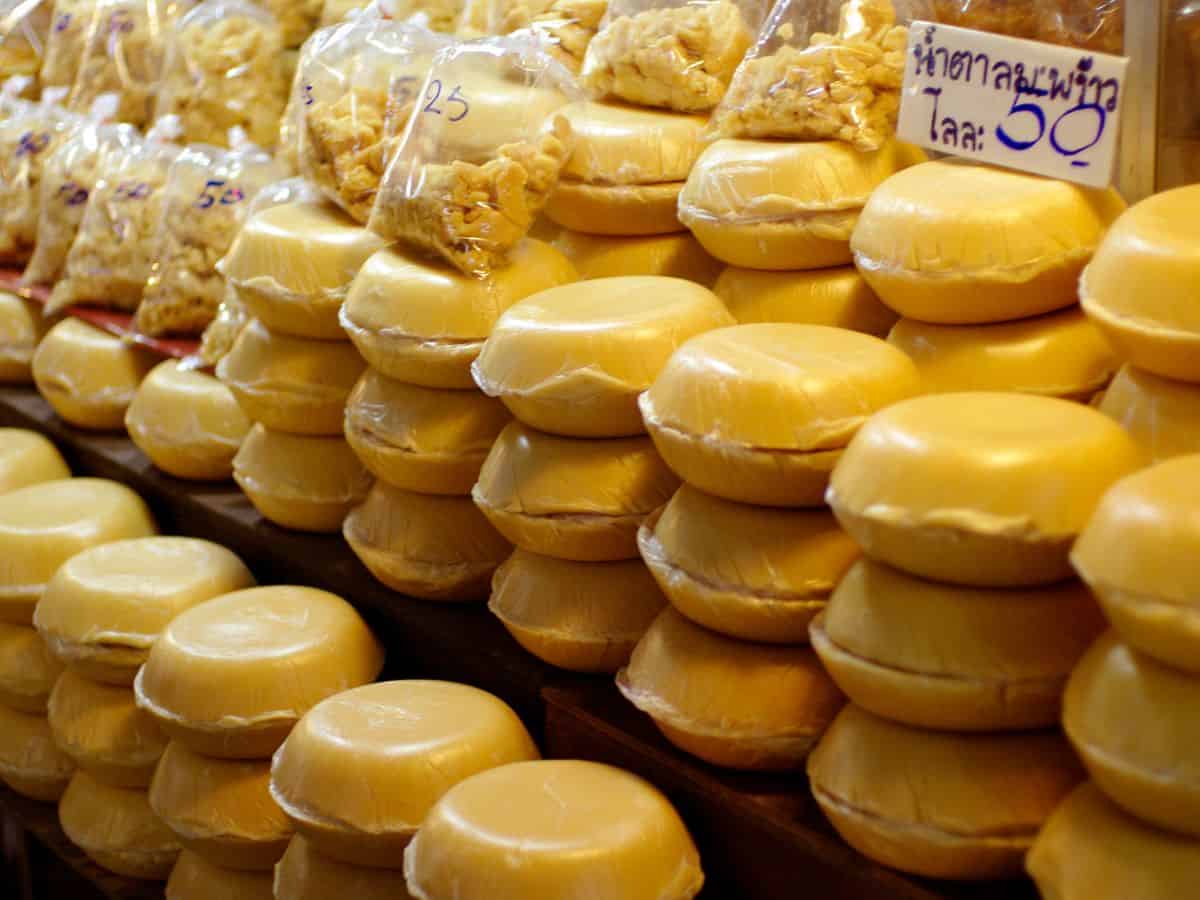
What's Covered In This Article?
Jump to:
- Watch The Video: Palm Sugar 101
- What exactly is palm sugar and coconut sugar?
- Is Palm Sugar, Jaggery and Gula Melaka The Same Thing?
- How is Palm Sugar Made?
- Are all palm sugars created equal?
- How to Choose Good Quality Palm Sugar?
- Choosing Between Hard vs Soft Palm Sugar
- What Palm Sugar or Coconut Sugar NOT To Buy for Thai Cooking
- How to Use Palm Sugar
- Measuring Palm Sugar For My Recipes
- How to store palm sugar
- Substituting Palm Sugar
- Recipes with Palm Sugar
Watch The Video: Palm Sugar 101
If you prefer to watch rather than read, most of the information covered in this article is also covered in this video. The one part I encourage you to watch is when I show you the 3 different brands of palm sugar of varying quality, so you can see what to look out for when shopping:
What exactly is palm sugar and coconut sugar?
Palm sugar is sugar that's made from the nectar of the flowers of *either* the coconut tree or the toddy palm tree (sometimes called sugar palm tree, pic below). If it's made from the coconut tree, then it's also called coconut sugar. In other words, coconut sugar is a type of palm sugar. So all coconut sugar is palm sugar, but not all palm sugar is coconut sugar, makes sense? 🙂

And in Thai, the generic term for all types of palm sugar is nam taan peep น้ำตาลปี๊ป or nam taan peuk น้ำตาลปึก. Coconut sugar is called nam taan maprao น้ำตาลมะพร้าว and sugar made from toddy palm is called nam taan tanoad น้ำตาลโตนด.
While the two sugars come from different plants, the flavor, however, are very, very similar. The one time I tasted them side by side I could tell that they were slightly different, but I couldn't identify which was which. So in Thai cooking palm sugar can be used interchangeably with coconut sugar, with some caveats. More on these caveats in the discussion around choosing the right palm sugar below.
Is Palm Sugar, Jaggery and Gula Melaka The Same Thing?
Jaggery is a term that's used to refer to any unrefined chunk of sugar. So yes, palm sugar is a type of jaggery, but you can also have jaggery made from cane juice that's been cooked down. In everyday speak however, we don't refer to Thai palm sugar as jaggery.
Gula melaka is the Malaysian term for palm sugar that is made from coconut nectar. Though the raw material is the same as Thai coconut palm sugar, gula melaka is reduced and caramelized further, as you can see in the pic below, so it is darker and has a different flavour. So the two are generally not interchangeable in recipes, especially if the sugar is added in large enough quantities that the flavour difference will be perceptible. So, you should use Thai palm sugar in Thai recipes, and gula melaka where it is called for specifically.
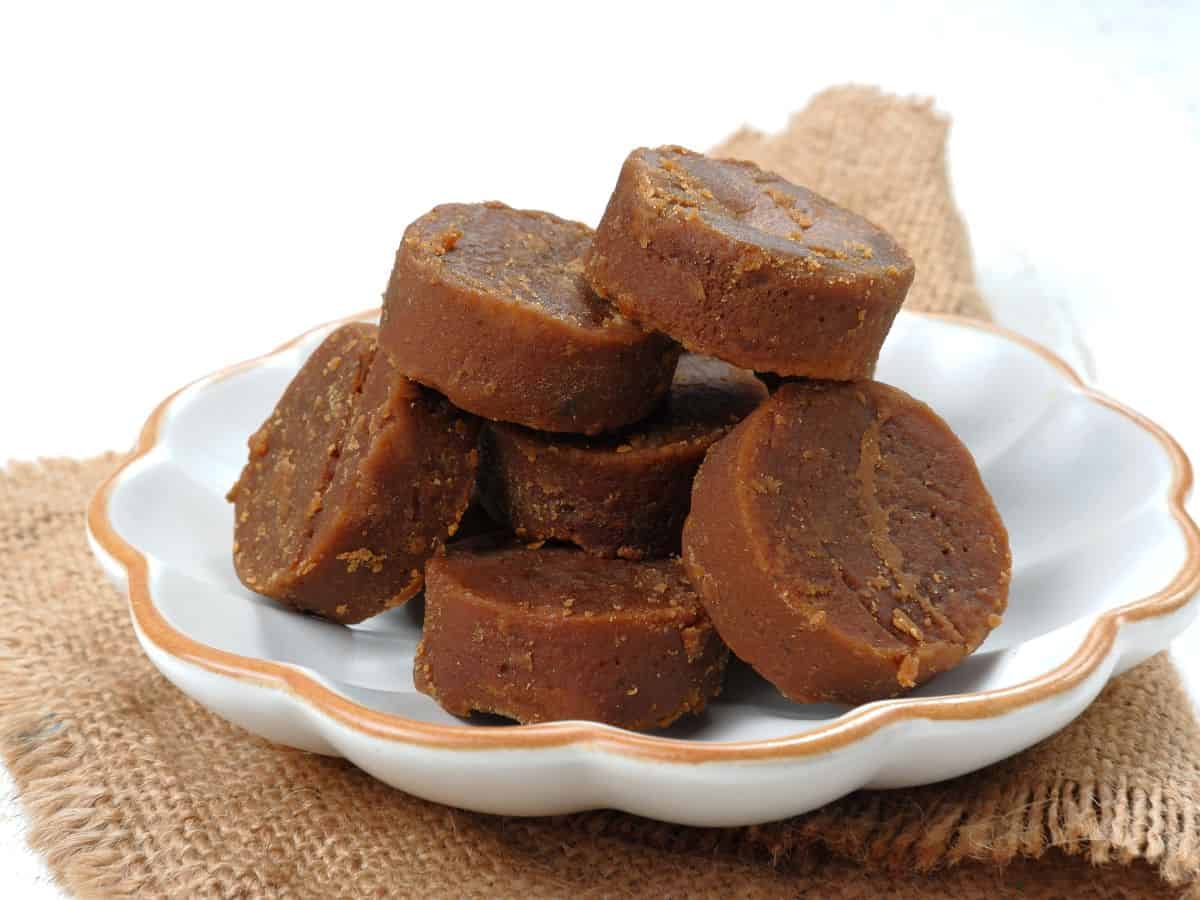
And to further clarify, palm sugar is also not the same as piloncillo or panela, which is made from sugar cane.
How is Palm Sugar Made?
Palm sugar is quite a labour intensive process. It's done in 4 major steps.
Step 1: Collecting the nectar.
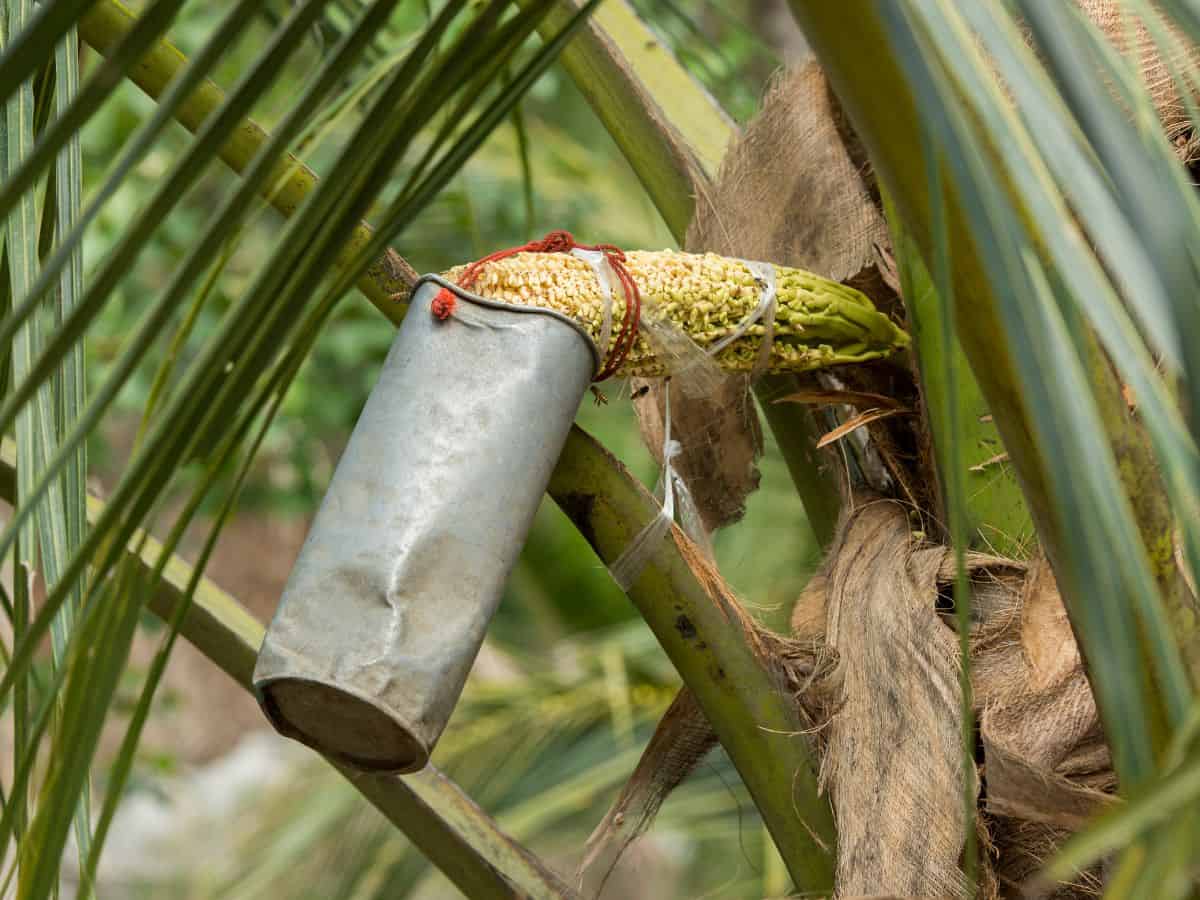
The palm sugar farmer first climbs up to the top of the tree to reach the flowers. They then cut the flowers and tie a bucket to it to collect the nectar that drips out. Now, you have to imagine that these are not short trees. Toddy palm trees can be anywhere from 25 to 40 meters tal (see pic above)l!! Coconut trees are not as tall, and this is why toddy palm sugar is less common - because it is much harder and more dangerous to collect their nectar.
The palm nectar starts out as a watery liquid that is aromatic, sweet and insanely delicious. You can get the nectar actually as a drink In Thailand, and it's one of my absolute favourite things to drink ice cold. I always seek out whenever I'm in Thailand.
Step 2: Reducing the sugar.
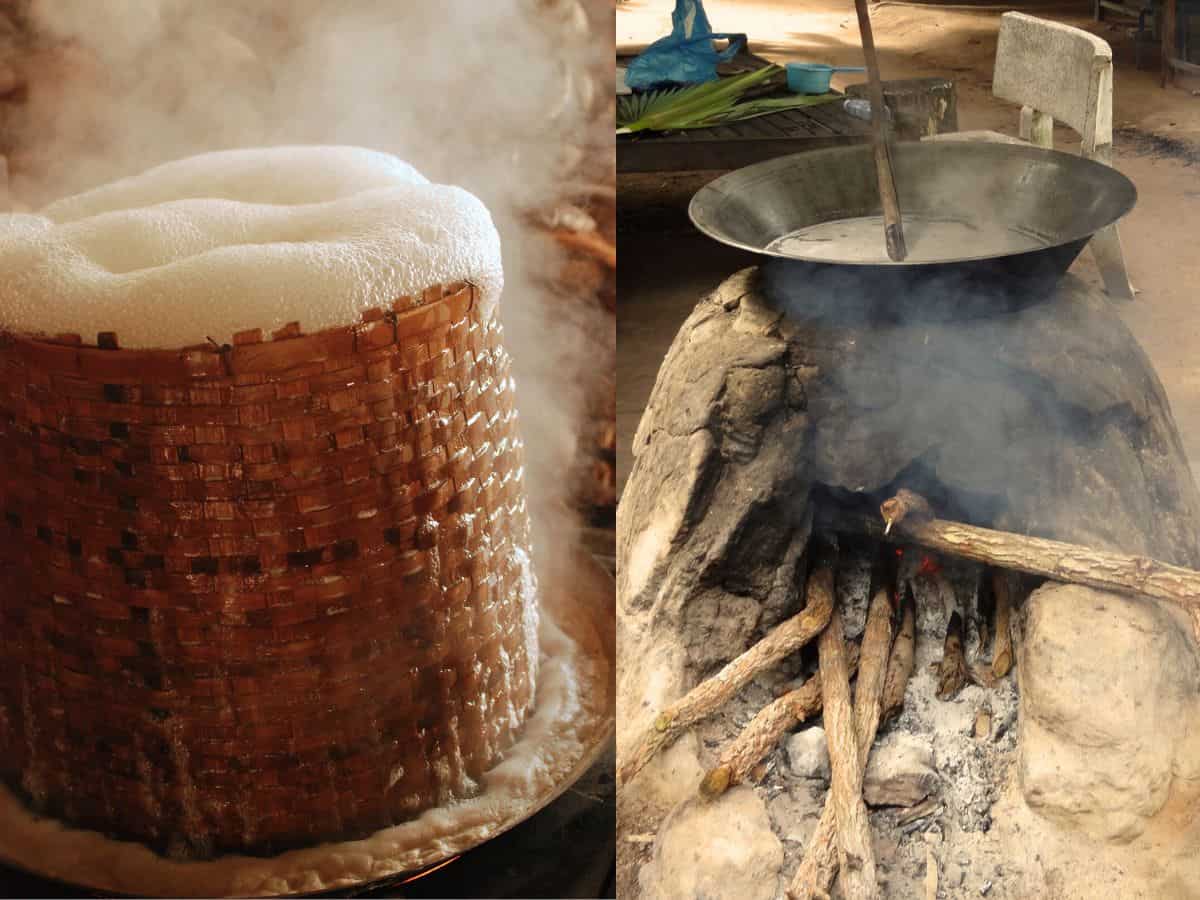
The nectar gets transferred to a large wok, and it is reduced over flame to evaporate the water so that you're left with is just the thick, caramelly, tasty syrup. It's a very similar idea to making maple syrup! At this point, non-artisanal makers will also add various amounts of granulated sugar as a filler. More on this below.
During the boiling process, a woven bamboo "cage" is placed in the wok (pic above) to prevent the syrup from boiling over.
Step 3: Whipping the sugar.
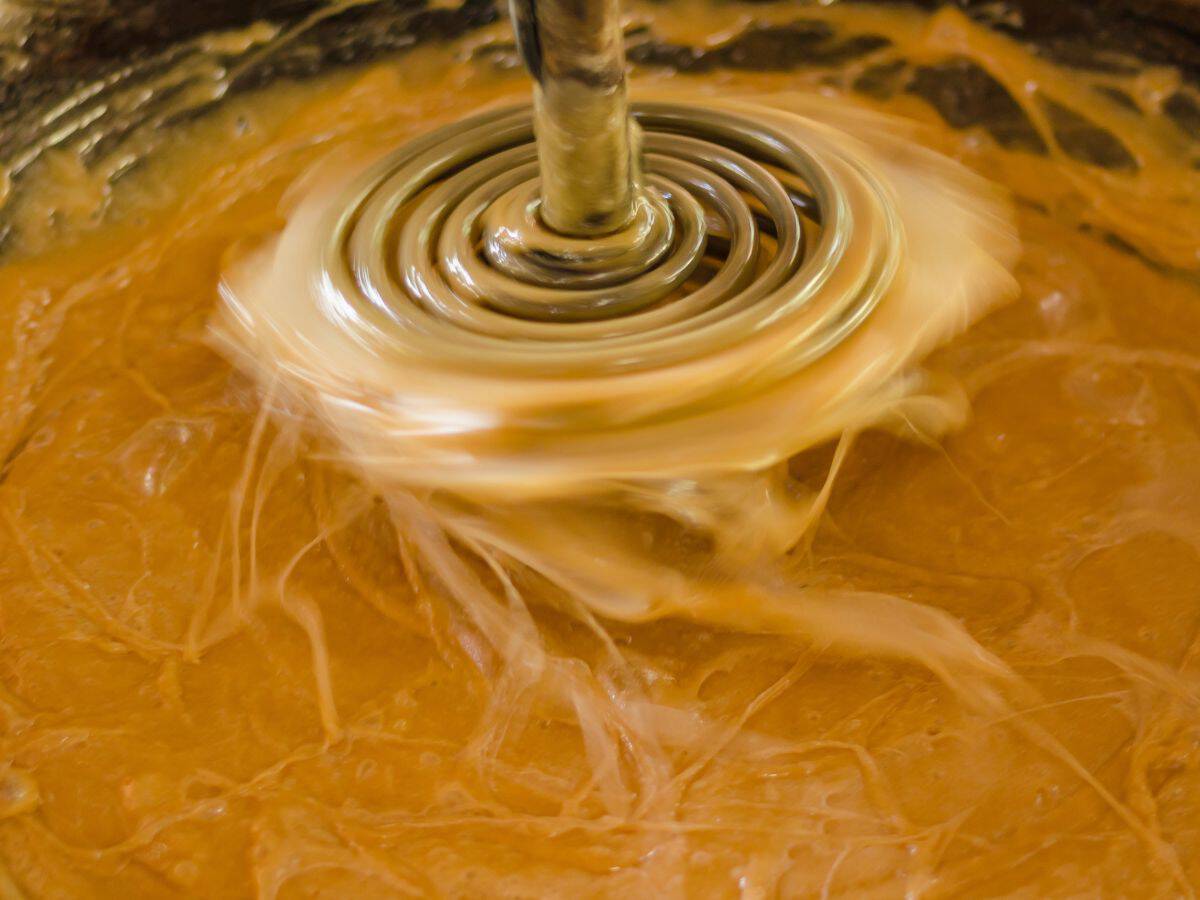
The hot syrup is then whipped using a springy whisk, or a machine (think a boat propeller attached to a stick blender). The aeration is so that the sugar will cool down quickly AND evenly. If they let the sugar cool without whipping it, it will cool from the outside in, causing the exterior to harden while the inside is still liquid.
Step 4: Placing the sugar into molds.

Once the sugar is cool enough that it is a thick paste, it'll either be packed into containers such as tubs or jars, or if they are to be sold as hard pucks, they will be placed into molds. The molds are usually round and can be small or large. The molds are lined with cloth to prevent sticking, and once the pucks are cool and hard they are packaged for sale.
Are all palm sugars created equal?
Nope. Not even close. As mentioned in Step 2 above, most producers of palm sugar add in some amount of granulated sugar as a filler, and I saw it with my own eyes during my visit to the palm sugar factory in Thailand.
As you saw, palm sugar is a labour intensive process and fewer and fewer Thai people are choosing this line of work, so there is way more demand for it than there is supply. There would never be enough palm sugar for everyone if it were all pure, and we'd probably all pay a very high price for it!
So the quality is determined by how much white granulated sugar is mixed in. When I spoke to the palm sugar maker during my visit, she said that it could be anywhere from 25% to 75% depending on the brand (the factory made palm sugar for many different brands, many of which are exported).
Essentially ALL Thai palm sugar available on the market, even in Thailand, is not pure. Yes, even if it says 100% palm sugar on the package, that is 100% a lie. Unfortunately there is no palm sugar police that makes sure the packaging is honest.
There is an opportunity to taste pure palm sugar, however, and that is if you visit a place that demonstrates how palm sugar is made traditionally in Thailand. These are usually open to visitors, and are more of an educational/touristy place than an actual sugar producer. What they do produce is a small amount that's sold mostly locally.
Save this recipe!
How to Choose Good Quality Palm Sugar?
If you're just looking at the sugar, it is quite hard to tell, but there are some signs. I encourage you to watch the video where I taste 3 different qualities of palm sugar so you'll see the differences more clearly that way.
But here's the bottom line: Looks can be deceiving, so the only real way to tell is to taste them side by side. The more palm necar it contains, the more flavourful and aromatic it will be. It will taste like a floral, butterscotch candy, not merely sugar.
Even though looks can be deceiving, it can tell you something. Most importantly, look for palm sugar with a smooth texture. It should not look crystalized, and it should not be very pale. The worst one I've seen is Cock Brand. It's so pale, and you can even see the granulated texture! It has a very faint palm sugar flavour with a crunchy texture that palm sugar should not have. This sugar has a TON of white sugar added. Of course it's the one that says 100% palm sugar on the packaging, which is obviously not true.
While you don't want super pale palm sugar, darker doesn't always mean better. A dark colour can also be imitated by adding brown sugar rather than white sugar. This is not a practice I've seen in palm sugar from Thailand, but I have seen it in palm sugar produced in Vietnam. While I think brown sugar is better than white sugar, cuz at least it has some flavour, colour alone should not be used as an indicator of purity.
Choose the more expensive one. If you have a few brands to choose from, I encourage you to choose the one with a higher price tag. Stores usually price items according to their cost, and if one palm sugar costs more than the other, you've got a higher chance that it is more pure. This is no guarantee of course, but since the difference in price is usually just a few bucks, I think it's worth the gamble.
Choosing Between Hard vs Soft Palm Sugar
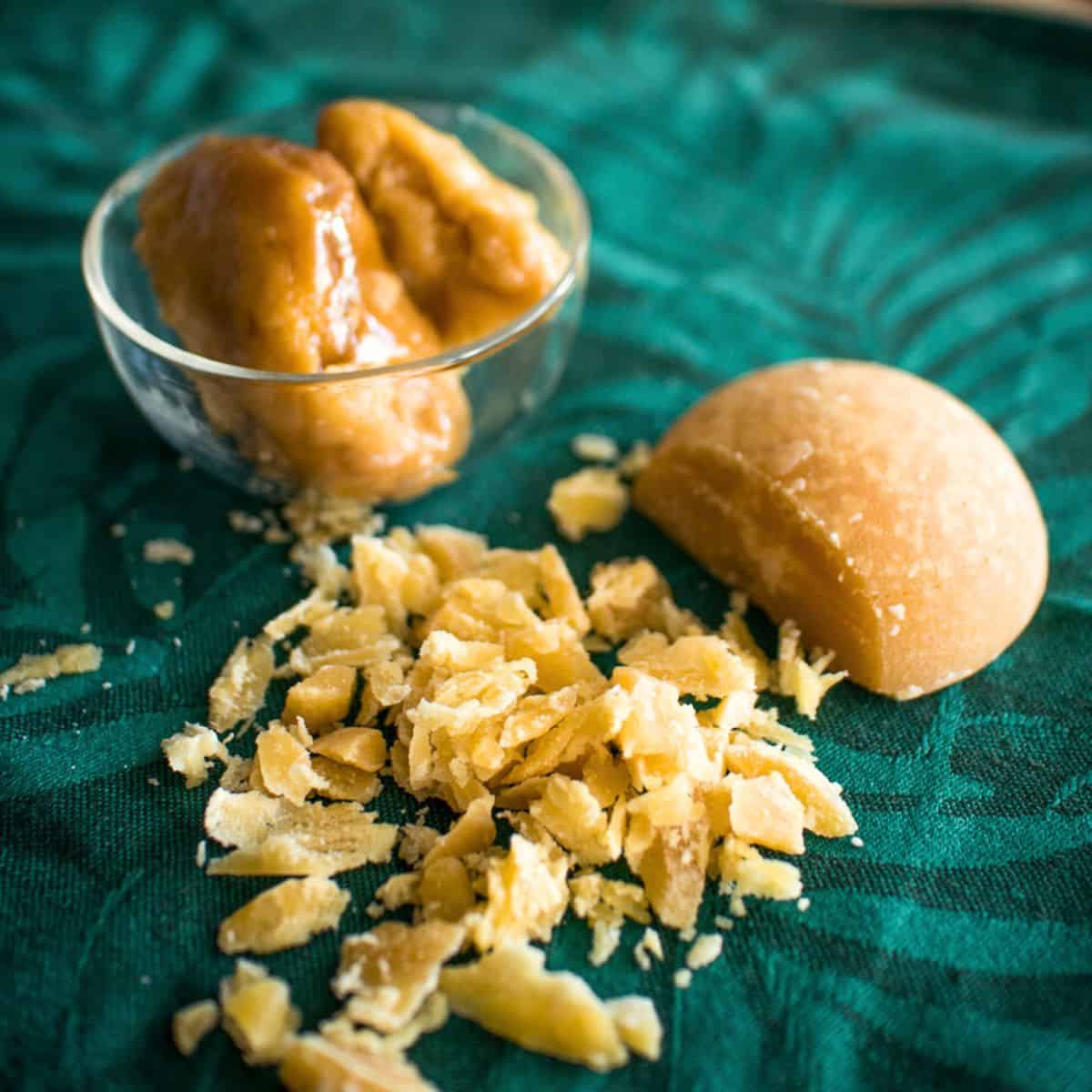
Palm sugar is sold in stores in two major forms, hard solid pucks and a soft paste in a tub or jar. Neither one indicates a better quality, but here's what you need to know:
Palm sugar can be reduced to various degrees, so if they leave enough moisture in the syrup, it will not completely harden once cool. This palm sugar is then packed into tubs, jars or even plastic bags, designed to be spooned out. This is the most common type in Thailand because we use palm sugar a lot, and the soft paste is more convenient to use, and it dissolves more easily.
But in the export market I more often see palm sugar in hard pucks, which is better if you don't cook with palm sugar often. Why? Because like brown sugar, palm sugar dries out over time. And if you've store palm sugar in a tub for a long time, it can completely solidify in the tub, making it a total pain to use. If this happens, check out the "how to use" section below.
So here I always buy the pucks of palm sugar, which can be chopped and then measured in a tablespoon (more on this below).
What Palm Sugar or Coconut Sugar NOT To Buy for Thai Cooking
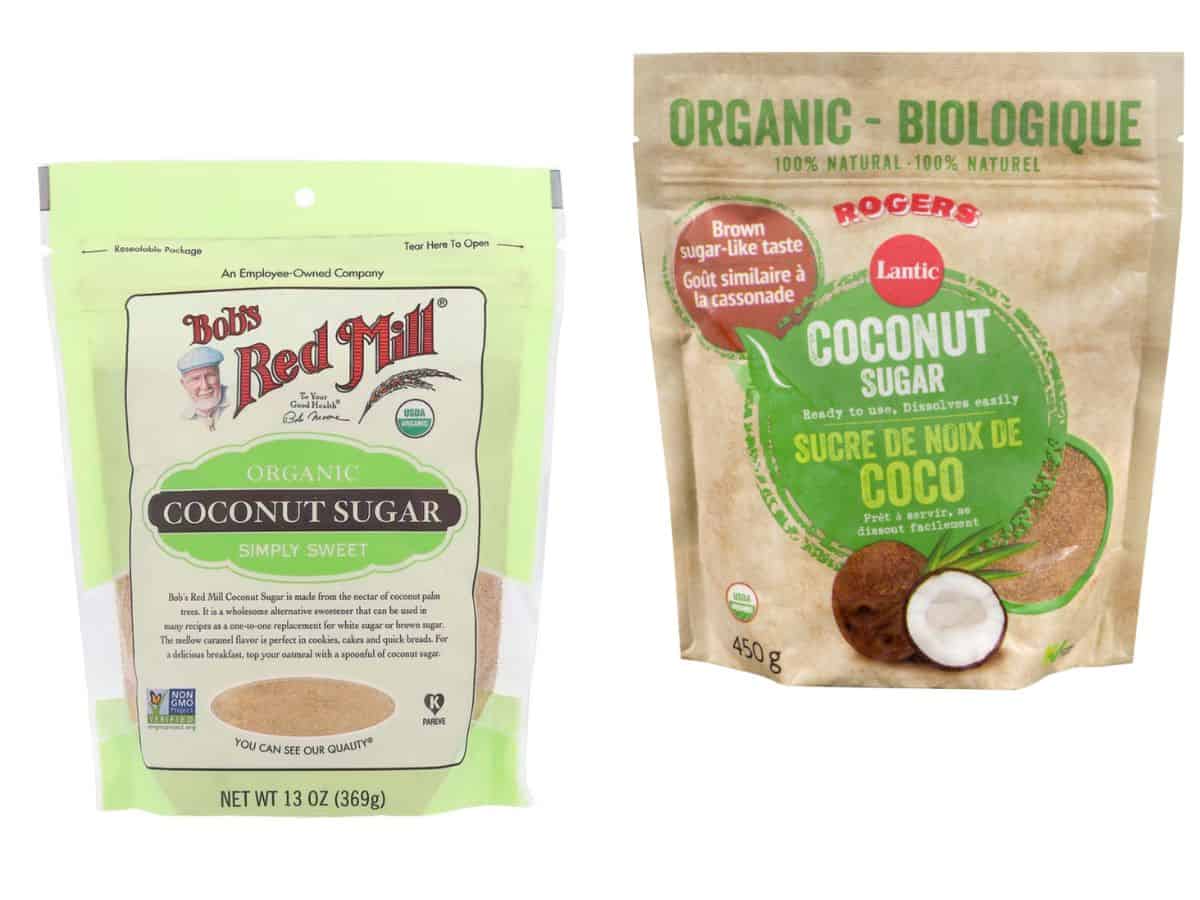
In recent years we've started to see granulated "coconut sugar" in non-Asian stores. Can those be used for Thai cooking? Well yes and no. Generally I encourage you to buy Thai palm sugar because that's how you ensure the right flavour profile, especially when making desserts. But let's go through some other products on the market that may cause confusion.
Some granulated coconut sugar is very dark and has an entirely different flavour, like the Roger's one above. It looks almost like dark brown sugar. And while it is made from the same stuff - coconut nectar - the processing is different resulting in a different tasting product. It's very toasty, almost a little smoky, burnt toast-ish. So this is not a good one to use in Thai recipes that call for palm sugar because the flavour difference is too much.
Some granulated coconut sugar is very light and has a much milder flavour. It CAN be used in Thai recipes because it won't introduce any off flavours like the dark one, but seeing as it is not caramelized at all, it has a lighter flavour than Thai palm sugar. The Bob's Red Mill coconut sugar looks like it's medium-dark, though I haven't personally tasted it so I can't comment on how well it'll work as a Thai palm sugar substitute.
Worth noting that Red Boat sells palm sugar from Cambodia that they claim is pure (and FWIW I believe it). But the processing must be quite different because it is so much darker and more acidic than Thai palm sugar. A little bit in savoury applications would be fine, but I would not to use it in Thai desserts where the intense flavours will be quite prominent.
How to Use Palm Sugar
If your palm sugar comes in a puck, simply chop it with a chef's knife, shaving it thinly with each stroke like you would a block of chocolate. Some people like to use a box grater, but I find it easier to chop.
Important: if your palm sugar is really old, it will have dried out and it will become so hard that chopping it will be nearly impossible without ruining the edge of your knife! So, if you know that you will have the sugar for a long time (say, a year) I would chop it all in advance to prevent such a situation.
If you end up with rock hard pucks of palm sugar, try whacking it in a heavy duty stone mortar and pestle and it'll break into bits.
If you have soft palm sugar from a tub and it's soft enough to spoon, great, spoon away. But if it has hardened, you'll need to heat it up in the microwave, then use a spoon to scoop it out while it is still warm. Work quickly because once it cools down, it'll harden again.
Measuring Palm Sugar For My Recipes
If you are measuring palm sugar by tablespoon or cup, finely chop it and then pack it tightly into the measuring spoon or cup. 1 Tablespoon of finely chopped packed palm sugar weighs about 12 grams.
If your palm sugar is a soft paste, you will need to use the weight measure provided in my recipes because more of it will pack into a measuring spoon. Or if you're willing to wing it, you can also just eyeball a little bit less than the volume called for.
How to store palm sugar
Palm sugar can be stored at room temp indefinitely. It's sugar and it won't go bad, BUT it can dry out. Make sure it's well sealed in an airtight container, and again, if you won't use it often, consider chopping it all in bulk while it's still soft.
Substituting Palm Sugar
What can I use instead of palm sugar? It depends. Generally, light brown sugar is a good all-purpose substitute, and it measures about the same in a tablespoon which is convenient!
If palm sugar is added in a small amount to a recipe with a lot of strong flavours, like a curry, then you can substitute with any other kind of sugar or sweetener you have because the flavour of the sugar won't come through.
But in a recipe where it is also contributing flavour, like in a salad, pad thai, and definitely in desserts, you want to use light brown sugar or perhaps you can try maple syrup, which has obviously a different flavour but might be good nonetheless!
Recipes with Palm Sugar
Want to start cooking with palm sugar? Here are a couple of recipes that really showcase the flavour of palm sugar:

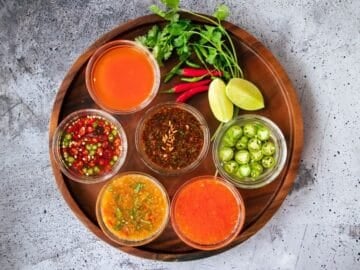
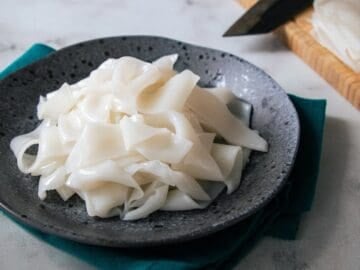


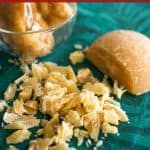
Gregorio Litenstein says
If I have both, do you think light brown sugar is generally still a better substitute than panela?
Noxolo says
Hi Pai! I was wondering if you could guide me on which brand i should buy online. Have you had good results with any? Thanks for the help 🙂
Andra says
I like your blog!
DAVID HAMILTON says
Hi Pailin-Love your videos!! I’m going to be in Bangkok in about a week-any recommendations for places to find better quality Palm sugar than we can find in the states? And, how do I ask a market vendor for it? Thanks a million!!
Dave says
Hi Pailin,
In the video you don't mention dark palm sugar, similar to this https://i.stack.imgur.com/psUOD.png which has a more caramilized flavour.
I don't have the book anymore but I recall a recipe which called for both light and dark palm sugars.
What is the source/process of the dark palm sugar?
btw, thank you for your informative posts.
cheers, Dave
Pailin Chongchitnant says
Hi Dave, I didn't talk about it because it is not an ingredient that is used in Thai cuisine. Theoretically it is made from the same stuff but is caramelized further and has a distinctly different flavour. Will note it as info to add in future post, however. Thanks for watching!
OEZ says
Hi Pailin- thank you for all of your excellent content. Regarding the best storage method for palm sugar, I live in an extremely dry climate. So other than wrapping it well and keeping it in a sealed container, can it be stored in the fridge or freezer to keep it from hardening? Thank you in advance!
Pailin Chongchitnant says
Yes, you can keep it in the fridge if you'd like. I keep it in the cabinet but for my good sugar I use a "terra cotta brown sugar saver" that helps keep the sugar moist longer.
Susan Hyon says
I got a palm sugar where the ingredients says: Coconut Syrup, Sugar. Contains: Coconut.
It is liquid-y so hard to measure (for pad thai sauce). Is this usable?
Thanks!
Pailin Chongchitnant says
Hi Susan, I'm not 100% sure and I would have to look at the product before I can say one way or another. It probably would be fine to use, but getting the right amount might be tricky. If you want to send me a pic of it you can email it at the email in the contact page!
lowandslow says
What about Mexican panela sugar?
Pailin Chongchitnant says
That's cane sugar and is not the same, but can be used as a substitute.
Aisah says
Hi I love your videos! I’m in Thailand now and I wonder if you’d know is gula melaka available here. If not, what would be a great substitute for gula melaka? I do prefer it in powder form 🤗
Pailin Chongchitnant says
In powdered form your best sub is using brown sugar. I've never seen gula melaka there.
Ken says
Can I use Gula Jawa in place of palm sugar, or would that alter the taste too much?
Pailin Chongchitnant says
From what I've seen gula jawa tends to have a much more intense flavour than Thai palm sugar and is much darker, and so yes it will alter the taste of food significantly if used in a large enough amount.
Susan says
Hi Palim
I was given a pack of Ban Phaeo palm sugar I'm in Singapore so just wondering can this be left out at room temperature or it needs to be kept in the fridge for a longer life span?
Thank you
Susan
Pailin Chongchitnant says
You can keep it at room temp, but make sure it's welk sealed!
Lana says
I live in San Diego and I can’t find palm sugar anywhere!!!!! Can someone please help
jose says
99 ranch market has palm sugar
Adam from HTK says
Thanks Jose!
Lana says
Thanks I’ll give them a call before I go, I’ve made this recipe before when I was in Australia but I just moved to the US, finding it so hard to adjust and find everything I normally use.
Adam from HTK says
Hi Lana! If you can't find anything re Jose's comment on 99 Ranch Market check out https://hot-thai-kitchen.com/locate-a-thai-grocer/ Cheers!
Kim says
I also got addicted to Palm sugar!
Mark says
None of the links go to the actual video. Kind of annoying!
https://www.youtube.com/watch?v=A32va3sLi5M
Adam from HTK says
Hi Mark, Adam here and sorry for the trouble! I've tried all the links in this post and in the video at https://www.youtube.com/watch?v=A32va3sLi5M howeverr, and everything seems to be working for me. Can you give me an example of a link that isn't working? Also do you have an "ad-blocker" running? That tends to break a lot of the content. Cheers!
Josh says
Hiii.. Can I substitute the palm sugar with normal sugar?
Thank youuuuu
Pailin Chongchitnant says
Light brown sugar is a better sub.
Jim says
Any comment on the Red Boat "pure" palm sugar from Cambodia? Wonder if it is the real deal like their fish sauce.
Stacy says
I tried soaking my palm sugar in water (after learning the trick from another video) to keep it in a softened state so I could scoop it out in its soft taffy texture. However, it just turned my entire jarful into a brownish red liquid. Do you know what went wrong?
Thank you for the very informative video!
Pailin Chongchitnant says
Sounds like it just dissolved your sugar due to too much water. Still usable though!
Beau says
This was so helpful! I've been baffled by the several types and packages and ingredient claims. Now I'm properly educated.
Frank says
can you tell me the difference between Thai Palm Sugar and "Gula Melaka"
I know they are both from Coconut sugar
Adam The HTK Minion says
Same raw material, but gula melaka is caramelized much darker. Cheers!